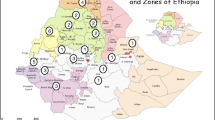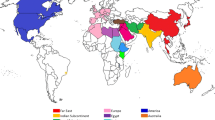Abstract
A set of 292 accessions of common wheat (Triticum aestivum L.) representing 21 germplasm pools based on geographical or breeding program origins was assayed for RFLP diversity. Thirty cDNA and genomic DNA probes and the HindIII restriction enzyme were employed for RFLP analysis. About 61% of all 233 scored bands were present in 75% or more of the accessions. All but one of the 30 probes revealed polymorphism, and the average number of distinct patterns per probe over all accessions was 9.5.Polymorphic Information Content (PIC) values within a pool varied from 0 to 0.9 and depended on the identities of both the germplasm pool and the probe. Rare banding patterns with a relative frequency of ≤0.2 within a pool were detected. These rare patterns were more likely to occur in pools exhibiting high levels of heterogeneity. The highest level of polymorphism was observed in the Turkish landraces from Southwest Asia. The Eastern U.S. soft red winter wheat germplasm pool was more genetically diverse than the other advanced germplasm pools, and nearly as diverse as the Turkish landrace pool. RFLP-based genetic relationships between germplasm pools generally tracked expectations based on common geographical origin, breeding history and/or shared parentages. The Chinese wheat landraces from Sichuan, Tibet, and Yunnan provinces were distinct from other pools. Similarity matrices for among-pool genetic distance estimates based on either band frequencies or banding pattern frequencies showed good correlation with matrices derived from Nei and Li's mean genetic similarity estimates (r=−0.82** and r=−0.73**, respectively.
Similar content being viewed by others
References
Anderson, J.A., Y. Ogihara, M.E. Sorrells & S.D. Tanksley, 1992. Development of a chromosomal arm map for wheat based on RFLP markers. Theor Appl Genet 83: 1035-1043.
Anderson, J.A., G.A. Churchill, J.E. Autrique, M.E. Sorells & S.D. Tanksley, 1993. Optimizing parental selection for genetic linkage maps. Genome 36: 181-186.
Autrique, E., M.M. Nachit, P. Monneveux, S.D. Tanksley & M.E. Sorrells, 1996. Genetic diversity in durum wheat based on RFLPs, morphological traits, and coefficient of parentage. Crop Sci 36: 735-742.
Clark, J.A. & B.B. Bayles, 1935. Classification of wheat varieties grown in the United States. USDA Tech Bull No. 459. Washington, DC.
Cox, T.S., 1991. The contribution of introduced germplasm to the development of US wheat cultivars. In: H.L. Shands & L.E. Wiesner (Eds.), Use of Plant Introductions in Cultivar Development, Part I. CSSA Spec. Publ. No. 17. CSSA, Madison, WI. pp. 25-47.
Cox, T.S., J.P. Murphy & D.M. Rodgers, 1986. Changes in genetic diversity in the red winter wheat regions of the United States. Proc Natl Acad Sci USA 83: 5583-5586.
Cox, T.S., G.L. Lookhart, D.E. Warker, L.G. Harrell, L.D. Albers & D.M. Rodgers, 1985. Genetic relationships among hard red winter wheat cultivars as evaluated by pedigree analysis and gliadin polyacrylamide gel electrophoretic patterns. Crop Sci 25: 1058-1063.
Donini, P., M.L. Elias, S.M. Bougourd & R.M.D. Koebner, 1997. AFLP fingerprinting reveals pattern differences between template DNA extracted from different plant organs. Genome 40: 521-526.
GrainGenes, 1998. A database for small grains and sugarcane. (Internet address: http://wheat.pw.usda.gov/).
Kim, H.S., 1995. Genetic diversity among wheat germplasm pools with diverse geographical origins. Ph.D. thesis, Michigan State Univ., East Lansing, USA.
Kim, H.S., & R.W. Ward, 1997. Genetic diversity in Eastern US soft winter wheat (Triticum aestivum L. em. Thell.) based on RFLPs and coefficients of parentage. Theor Appl Genet 94: 472-479.
Lupton, F.G.H., 1987. History of wheat breeding. In: F.G.H. Lupton (Ed.), Wheat Breeding, pp. 51-70. Chapman and Hall. London and New York.
Lubbers, E.L., K.S. Gill, T.S. Cox & B.S. Gill, 1991. Variation of molecular markers among geographically diverse accessions of Triticum tauschii. Genome 34: 354-361.
Martynov, S.P., T.V. Dobrotvorskaya, Z. Stehno, L. Dotlacil, I. Faberova & I. Holubec, 1992. Genealogy and gene alleles identified in 31,1000 cultivars and lines of wheat. vol. I and II. Information and Computation Centre, Russian Academy of Agricultural Sciences, Tver, Russia Research Institute of Crop Production, Prague, Czechoslovakia.
Metakovsky, E.V. & G. Branlard, 1998. Genetic diversity of French common wheat germplasm based on gliadin alleles. Theor Appl Genet 96: 209-218.
Murphy, J.P., T.S. Cox & D.M. Rodgers, 1986. Cluster analysis of red winter wheat cultivars based upon coefficients of parentage. Crop Sci 26: 672-676.
Nei, M., 1972. Genetic distance between populations. Amer Naturalist 106: 283-292.
Nei, M. & W. Li, 1979. Mathematical model for studying genetic variation in terms of restriction endonucleases. Proc Natl Acad Sci USA 76: 5269-5273.
Nightingale, K.J., 1996. Trends in genetic diversity in spring wheat in the developing world. Master's thesis, Michigan State Univ., East Lansing, USA.
Patterson, F.L. & R.E. Allan, 1981. Soft wheat breeding in the United States. In: W.T. Yamazaki & C.T. Greenwood (Eds.), Soft Wheat: Production, Breeding, Milling, and Uses, pp. 33-98. American Association of Cereal Chemical. Inc St Paul Minnesota.
Roder, M.S., J. Plaschke, S.U. Konig, A. Borner, M.F. Sorrells, S.D. Tanksley & M.W. Ganal, 1995. Abundance, variability and chromosomal location of microsatellites in wheat. Mol Gen Genet 246: 327-333.
Rohlf, F.J., 1992. NTSYS-pc, Numerical taxonomy and multivariate analysis system. ver. 1.7. Exter Publishing Ltd., Setauket, New York.
Siedler, H., M.M. Messmer, G.M. Schachermayr, H. Winzeler, M. Winzeler & B. Keller, 1994. Genetic diversity in European wheat and spelt breeding material based on RFLP data. Theor Appl Genet 88: 994-1003.
Smale, M., 1995. Ongoing Research at CIMMYT: Understanding wheat genetic diversity and international flows of genetic resources. Part 1 of CIMMYT World Wheat Facts and Trends Supplement, 1995. Mexico, D.F.: CIMMYT.
Ward, R.W., Z.L. Yang, H.S. Kim & C. Yen, 1998. Comparative analyses of RFLP diversity in landraces of Triticum aestivum and collections of T. tauschii from China and Southwest Asia. Theor Appl Genet 96: 312-318.
Author information
Authors and Affiliations
Rights and permissions
About this article
Cite this article
Kim, H., Ward, R. Patterns of RFLP-based genetic diversity in germplasm pools of common wheat with different geographical or breeding program origins. Euphytica 115, 197–208 (2000). https://doi.org/10.1023/A:1004022601879
Issue Date:
DOI: https://doi.org/10.1023/A:1004022601879




